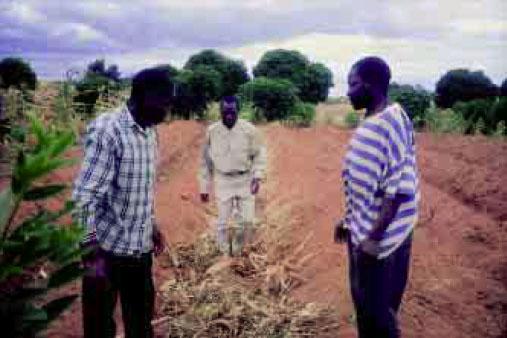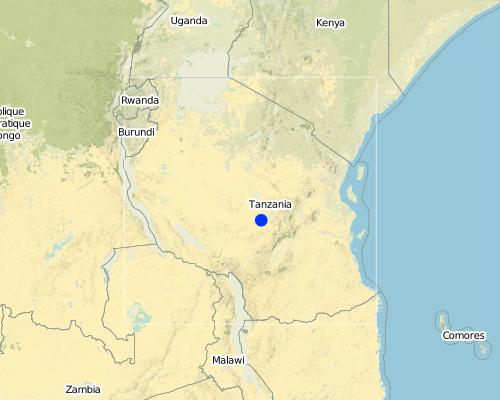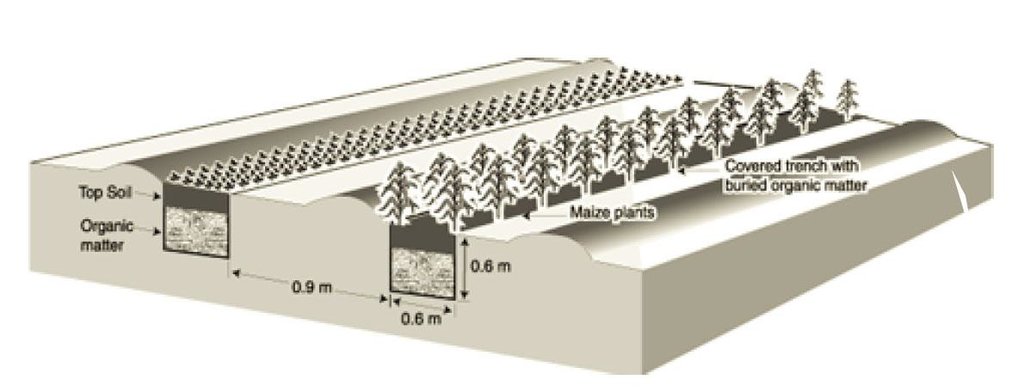In-situ compost cultivation or ‘pattern farming’ [تنزانيا، جمهورية تنزانيا المتحدة]
- تاريخ الإنشاء:
- تحديث:
- جامع المعلومات: Patrick Gervas Mbanguka Lameck
- المحرر: –
- المُراجع: David Streiff
Kilimo cha mfumo (Kiswahili)
technologies_1122 - تنزانيا، جمهورية تنزانيا المتحدة
عرض الأقسام
توسيع الكل طي الكل1. معلومات عامة
1.2 تفاصيل الاتصال بالأشخاص الرئيسيين لمصدر المعلومات والمؤسسات المشاركة في تقييم وتوثيق التقنية
الشخص (الأشخاص) الرئيسي لمصدر المعلومات
متخصص في الإدارة المستدامة للأراضي:
اسم المؤسسة (المؤسسات) التي سهلت توثيق/تقييم التقنية (إذا كان ذلك على صلة)
Inades Formation Tanzania (Inades Formation Tanzania)1.3 الشروط المتعلقة باستخدام البيانات الموثقة من خلال WOCAT
متى تم تجميع البيانات (ميدانيا)؟:
12/12/1999
يوافق جامع المعلومات والشخص (لاشخاص) الرئيسي لمصدر المعلومات على الشروط المتعلقة باستخدام البيانات الموثقة من خلال WOCAT:
نعم
2. وصف تقنيةالإدارة المستدامي للأراضي
2.1 وصف مختصر للتقنية
تعريف التقنية:
In-situ compost trench cultivation
2.2 وصف تفصيلي للتقنية
الوصف:
The system is based on trench cultivation. This involves excavation of trenches 0.6 m deep and 0.6 m wide, more or less across the slope, at a spacing of 0.9 m apart, edge to edge. The trenches are dug in the dry period, then filled with crop residues, grass and other organic trash, and finally back-filled with soil.
The surface is deliberately left some centimetres below ground level so that it can capture runoff. Associated with the trenching, a furrow to harvest rainwater is formed to lead water into the field from outside, and an end bund in the field is built up to prevent its loss. Between trenches a leguminous crop such as groundnuts is grown, while maize, sweet potatoes and tomatoes are grown on the trenches. In the first year, the farmer plants at the sides of the trench to avoid damage to crop roots by the heat generated by decomposition. Thereafter crops are planted in the middle. In years of good rainfall it is possible to grow an opportunistic second crop, making use of stored soil moisture. After four years the trench is re-dug, filled with organic matter, and the cycle begins. Further additions/ improvements to the system (which is
constantly evolving) are (i) the addition of cattle urine and waste water from the household to hasten decomposition of grass materials; and (ii) mulching between the trenches with crop stover at the end of the season.
Purpose of the Technology: The technology comprises a structural measure, dedicated to improvement of the land for annual cropping. In respect to soil and water conservation it primarily addresses soil fertility and soil moisture problems. It achieves impact through increasing organic matter and water stored in the soil. Ecological benefits include increase in soil moisture, improved soil fertility and protection of the land from surface erosion.
Establishment / maintenance activities and inputs: The land was completely bare before the technology and is now productive. Compared with neighbouring farms yields are estimated to be at least 50% higher, and the farmer considers the benefits to be ‘very positive’ in relation to the costs. This is reflected in his increased farm income. Those cost, however, are estimated at around 400 person days per hectare for initial establishment.
Natural / human environment: This technology was designed by a retired agricultural field agent on his 3 ha of land. The importance of this particular innovation lies in the fact that the originator has mixed and matched tradition and modern practices to tailor-make a system that suits his own situation.
2.3 صور التقنية
2.5 البلد/المنطقة/المواقع التي تم تنفيذ التقنية فيها والتي يغطيها هذا التقييم
البلد:
تنزانيا، جمهورية تنزانيا المتحدة
المنطقة/الولاية/المحافظة:
Dodoma
مزيد من التفاصيل حول الموقع:
Dodoma rural
Map
×2.6 تاريخ التنفيذ
في حالة عدم معرفة السنة بالتحديد، يرجى الإشارة إلى التاريخ التقريبي:
- منذ أقل من 10 سنوات (مؤخرًا)
2.7 إدخال التقنية
حدد كيف تم إدخال التقنية:
- من خلال ابتكار مستخدمي الأراضي
التعليقات (نوع المشروع، الخ):
farmer intiative
3. تصنيف تقنية الإدارة المستدامي للأراضي
3.1 الغرض الرئيسي ( الأغراض الرئيسية) للتقنية
- تحسين الإنتاج
- الحد من تدهور الأراضي ومنعه وعكسه
3.2 نوع (أنواع) استخدام الأراضي الحالية حيث يتم تطبيق التقنية

الأراضي الزراعية
- زراعة سنوية
المحاصيل الرئيسية (المحاصيل النقدية والغذائية):
major cash crop and major food crop: Maize
other: Groundnut
التعليقات:
Major land use problems (compiler’s opinion): declining soil fertility, moderate erosion and declining soil cover
Major land use problems (land users’ perception): as above
3.3 مزيد من المعلومات حول استخدام الأراضي
عدد مواسم الزراعة في السنة:
- 1
حدد:
Longest growing period in days: 120; Longest growing period from month to month: Dec - Apr; Second longest growing period in days: 90; Second longest growing period from month to month: Sep - Dec
3.4 مجموعةالإدارة المستدامة للأراضي التي تنتمي إليها هذه التقنية
- الإدارة المتكاملة لخصوبة التربة
3.5 انتشار التقنية
حدد انتشار التقنية:
- منتشرة بالتساوي على مساحة
إذا كانت التقنية منتشرة بالتساوي على منطقة ما، فحدد المنطقة التقريبية المغطاة:
- 100-10 كم2
3.6 التدابير التقنية في مجال إلادارة المستدامة للأراضي

التدابير الزراعية
- A2: المادة العضوية/خصوبة التربة

التدابير البنيوية
- S4: تسوية الخنادق والحفر
التعليقات:
Type of agronomic measures: legume inter-planting, manure / compost / residues, furrows (drainage, irrigation)
3.7 الأنواع الرئيسية من تدهور الأراضي التي تناولتها التقنية

تآكل التربة بالمياه
- الوزن(Wt): فقدان التربة السطحية/تآكل السطح

التدهور الكيميائي للتربة
- (Cn): تراجع الخصوبة وانخفاض محتوى المادة العضوية (غير ناتج عن الانجراف)

تدهور المياه
- (Ha): التجفيف
التعليقات:
Secondary types of degradation addressed: Ha: aridification
3.8 منع أو حد أو عكس تدهور الأراضي
تحديد هدف التقنية فيما يتعلق بتدهور الأراضي:
- اصلاح/إعادة تأهيل الأراضي المتدهورة بشدة
4. المواصفات الفنية، وأنشطة التنفيذ، والمدخلات، والتكاليف
4.1 الرسم الفني للتقنية
4.2 المواصفات الفنية/شروحات الرسم الفني
Cross-section of compost trench cultivation
Location: Dodoma. Tanzania
Technical knowledge required for field staff / advisors: moderate
Technical knowledge required for land users: low
Main technical functions: control of dispersed runoff: retain / trap, increase in organic matter, water harvesting, increase in soil fertility
Secondary technical functions: reduction of slope length, improvement of ground cover, increase of surface roughness
Legume inter-planting
Remarks: between trenches
Manure / compost / residues
Material/ species: compost, grass, other organic trash
Remarks: trenches filled with organic material
Furrows (drainage, irrigation)
Remarks: to harvest rainwater and bring it into the field
Structural measure: trench 2'*2'
Vertical interval between structures (m): 0.6
Spacing between structures (m): 0.3
Depth of ditches/pits/dams (m): 0.6
Length of ditches/pits/dams (m): 0.15
Height of bunds/banks/others (m): 0.2
4.4 أنشطة التأسيس
| النشاط | نوع التدبير | التوقيت | |
|---|---|---|---|
| 1. | layout, excavation, construction of bunds | بنيوية أو هيكلية | before rains |
| 2. | filling of trash and organic matter | بنيوية أو هيكلية | during rains |
4.5 التكاليف والمدخلات اللازمة للتأسيس
| تحديد المدخلات | الوحدة | الكمية | التكاليف لكل وحدة | إجمالي التكاليف لكل مدخل | % من التكاليف التي يتحملها مستخدمو الأراضي | |
|---|---|---|---|---|---|---|
| العمالة | Labour | persons/day/ha | 417,0 | 1,9 | 792,3 | 100,0 |
| معدات | Tools | ha | 1,0 | 8,5 | 8,5 | 100,0 |
| المواد النباتية | Seeds | ha | 1,0 | 7,5 | 7,5 | 100,0 |
| إجمالي تكاليف إنشاء التقنية | 808,3 | |||||
التعليقات:
Duration of establishment phase: 12 month(s)
4.6 الصيانة/الأنشطة المتكررة
| النشاط | نوع التدبير | التوقيت/الوتيرة | |
|---|---|---|---|
| 1. | excavating the trenches | زراعية | aug-nov / occassionally |
| 2. | collecting of organic matter | زراعية | before rains / occassionally |
| 3. | burying of the organic matter | زراعية | before rains / occassionally |
| 4. | sowing of seeds | زراعية | during rain / annually |
| 5. | harvesting | زراعية | dry season / annually |
| 6. | after 3 years excavate | بنيوية أو هيكلية | dry season/after 3years |
| 7. | add organic matter | بنيوية أو هيكلية | each cropping season |
4.7 التكاليف والمدخلات اللازمة للصيانة/للأنشطة المتكررة (سنويًا)
| تحديد المدخلات | الوحدة | الكمية | التكاليف لكل وحدة | إجمالي التكاليف لكل مدخل | % من التكاليف التي يتحملها مستخدمو الأراضي | |
|---|---|---|---|---|---|---|
| العمالة | Labour | persons/day/ha | 139,0 | 1,9 | 264,1 | 100,0 |
| معدات | Tools | ha | 1,0 | 8,5 | 8,5 | 100,0 |
| المواد النباتية | Seeds | ha | 1,0 | 7,5 | 7,5 | 100,0 |
| إجمالي تكاليف صيانة التقنية | 280,1 | |||||
4.8 أهم العوامل المؤثرة على التكاليف
قدم وصفا لأهم العوامل التي تؤثر على التكاليف:
labour for trench cultivation
5. البيئة الطبيعية والبشرية
5.1 المناخ
هطول الأمطار السنوي
- < 250 مم
- 251- 500 ملم
- 501 - 750ملم
- 1,000-751 ملم
- 1,500-1,100 ملم
- 2,000-1,500 ملم
- 3,000-2,001 ملم
- 4,000-3,100 ملم
- > 4000 ملم
المواصفات/التعليقات على هطول الأمطار:
Also 500-750 mm
المنطقة المناخية الزراعية
- شبه قاحلة
- قاحلة
5.2 طوبوغرافيا
متوسط الانحدارات:
- مسطح (0-2%)
- بسيط (3-5%)
- معتدل (6-10%)
- متدحرج (11-15%)
- تلال (16-30%)
- شديدة الانحدار(31-60%)
- فائقة الانحدار (>60%)
التضاريس:
- هضاب/سهول
- أثلام مرتفعة
- المنحدرات الجبلية
- منحدرات التلال
- منحدرات في السفوح
- قاع الوادي
المنطقة الارتفاعية:
- 100-0 متر فوق سطح البحر
- 500-101 متر فوق سطح البحر
- 1,000-501 متر فوق سطح البحر
- 1,500-1,001 متر فوق سطح البحر
- 2,000-1,501 متر فوق سطح البحر
- 2,500-2,100 متر فوق سطح البحر
- 3,000-2,501 متر فوق سطح البحر
- 4,000-3,001 متر فوق سطح البحر
- > 4000 متر فوق سطح البحر
التعليقات والمواصفات الإضافية بشأن التضاريس:
Slopes on average: Also hilly and gentle
Landforms: Also footslopes and valley floors
5.3 التربة
متوسط عمق التربة:
- ضحل جدًا (0-20 سم)
- ضحلة (21-50 سم)
- متوسطة العمق (51-80 سم)
- عميقة (81-120 سم)
- عميقة جدًا (> 120 سم)
قوام التربة (التربة السطحية):
- متوسط ( طميي، سلتي)
المواد العضوية في التربة السطحية:
- منخفضة (<1%)
إذا كان متاحًا، قم بإرفاق وصف كامل للتربة أو تحديد المعلومات المتوفرة، على سبيل المثال نوع التربة، الرقم الهيدروجيني/ درجة حموضة التربة، قدرة التبادل الكاتيوني، النيتروجين، الملوحة وما إلى ذلك.
Soil fertility is low
Soil drainage / infiltration is medium
Soil water storage capacity is medium
5.6 خصائص مستخدمي الأراضي الذين يطبقون التقنية
الدخل من خارج المزرعة:
- أقل من % 10من كامل الدخل
المستوى النسبي للثروة:
- ضعيف
- متوسط
اذكر الخصائص الأخرى ذات الصلة لمستخدمي الأراضي:
Population density: 10-50 persons/km2
Annual population growth: 2% - 3%
3% of the land users are rich and own 35% of the land.
40% of the land users are average wealthy and own 40% of the land.
40% of the land users are poor and own 15% of the land.
17% of the land users are poor and own 10% of the land.
5.7 متوسط مساحة الأرض المملوكة أو المستأجرة من قبل مستخدمي الأراضي الذين يطبقون التقنية
- < 0.5 هكتارا
- 0.5 - 1 هكتار
- 1 -2 هكتار
- 2 - 5 هكتار
- 5 - 15 هكتار
- 15 - 50 هكتار
- 50 - 100هكتار
- 500-100 هكتار
- 1,000-500 هكتار
- 10,000-1,000 هكتار
- > 10,000 هكتار
التعليقات:
Average area of land owned or leased by land users applying the Technology: Also 1-2 ha
5.8 ملكية الأراضي، وحقوق استخدام الأراضي، وحقوق استخدام المياه
ملكية الارض:
- فردية، لا يوجد سند ملكية
- فردية، يوجد سند ملكية
6. الآثار والتصريحات الختامية
6.1 الآثار التي أظهرتها التقنية في الموقع
الآثار الاجتماعية والاقتصادية
الإنتاج
إنتاج المحاصيل
إنتاج الأعلاف
الدخل والتكاليف
دخل المزرعة
الآثار الاجتماعية والثقافية
المؤسسات المجتمعية
المؤسسات الوطنية
الآثار الايكولوجية
التربة
رطوبة التربة
غطاء التربة
فقدان التربة
الآثار الايكولوجية الأخرى
soil fertility
biodiversity
6.2 الآثار التي أظهرتها التقنية خارج الموقع
الفيضان في اتجاه مجرى النهر
تراكم الطمي باتجاه مصب النهر
6.4 تحليل التكلفة والعائد
كيف يمكن مقارنة العوائد نسبة لتكاليف الإنشاء (من وجهة نظر مستخدمي الأراضي)؟
عوائد قصيرة الأجل:
إيجابي
عوائد طويلة الأجل:
ايجابي جدا
كيف تتم مقارنة العوائدمع كلفة الصيانة/التكاليف المتكررة (من وجهة نظر مستخدمي الأراضي)؟
عوائد قصيرة الأجل:
إيجابي
عوائد طويلة الأجل:
ايجابي جدا
6.5 اعتماد التقنية
- 50-10%
إذا كان متاحًا، قم بتحديد الكمية (عدد الأسر المعيشية و/أو المساحةالمغطاة):
60 households (20 percent of land users)
من بين جميع الذين تبنوا التقنية، كم عدد الذين فعلوا ذلك بشكل تلقائي، أي دون تلقي أي حوافز مادية/مدفوعات؟:
- 100-90%
التعليقات:
60 land user families have adopted the Technology without any external material support
Comments on spontaneous adoption: estimates
There is a little trend towards spontaneous adoption of the Technology
Comments on adoption trend: This is not one of the most quickly adopted initiatives – almost certainly due to the considerable labour involved. However of the 20 who have copied Albert (or modified the idea, as one close neighbour has done) several are women.
6.7 نقاط القوة / المزايا / الفرص التي توفرها التقنية
| نقاط القوة/ المزايا/ الفرص من وجهة نظر مستخدمي الأراضي |
|---|
| improves soil fertility |
| improves soil moisture |
| نقاط القوة/ المزايا/ الفرص من وجهة نظر جامع المعلومات أو غيره من الاشخاص الرئيسيين لمصدر المعلومات |
|---|
|
improve soil fertility from organic matter How can they be sustained / enhanced? replace organic matter |
|
conserve more moisture How can they be sustained / enhanced? improves moisture |
| increase yields by 300% |
6.8 نقاط ضعف / مساوىء / مخاطر التقنية وسبل التغلب عليها
| نقاط الضعف/ المساوىء/ المخاطر من وجهة نظر جامع المعلومات أو غيره من الاشخاص الرئيسيين لمصدر المعلومات | كيف يمكن التغلب عليها؟ |
|---|---|
| heavy earth works | hire labour |
| not applicable to certain soils like graverly |
7. المراجع والروابط
7.2 المراجع للمنشورات المتاحة
العنوان، المؤلف، السنة، النظام القياسي الدولي لترقيم الكتب ISBN:
farmer innovators workshop report
متاح من أين؟كم التكلفة؟:
invades UNDP-DSM tanzania
العنوان، المؤلف، السنة، النظام القياسي الدولي لترقيم الكتب ISBN:
Kithinji M., Critchley W. 2001. Farmers' initiatives in land husbandry: Promising technologies for the drier areas of East Africa. RELMA Technical Report series no. 27
الروابط والوحدات المواضيعية
توسيع الكل طي الكلالروابط
لا يوجد روابط
الوحدات المواضيعية
لا يوجد وحدات مواضيعية





